Bug Blog #4: Our Bud, The Scud
Welcome back to our fourth edition of Bug Blogs, celebrating Science Odyssey by showcasing benthic macroinvertebrates (bugs!) that we often find during our local stream studies program, Changing Currents.
In this installment of EcoSpark’s Bug Blogs, we will be examining scuds. Scuds are one of the easiest bottom dwelling bugs to identify in aquatic ecosystems due to their resemblance to shrimp. They have been nicknamed ‘side swimmers’ due to their distinct style of movement in water which can be viewed in the video below.
Amiphoda, the Latin name for the order to which scuds belong, may be adapted to a diverse range of habitats and various species are found all over the Great Lakes ecosystem. More than six thousand species have been found to date with well over one thousand found in fresh water!
Importance in the Food Chain
Because these benthics are adapted to a wide range of conditions, they can be herbivores, carnivores, scavengers or parasites, depending on the species. However, they are largely scavengers (like vultures!) eating organic debris such as dead leaves and other detritus (dead organic matter). As such, scuds play a big part in the recycling of nutrients into living tissue. They also play an important role in the food web because they are an important source of food for various fish species as well as ducks! Because they are important in nutrient cycling, they also are used to study specific contaminants such as PCBs and DDT in aquatic ecosystem. Interestingly, scuds look exactly like their adult selves when they hatch from their eggs, only smaller and only live for about a year with some able to live for over two.
The Hilsenhoff Biotic Index
When measuring water quality, benthics are assigned numbers on a scale ranging from 1-8 to determine how resistant they are to pollution with 1 being the most resistant and 8 being the least. This scale is used by EcoSpark and conservation authorities to determine water quality in different ecosystems. You can take a look at a visual representation of the scale used by EcoSpark here: https://www.ecospark.ca/learn-benthics. Scuds have a tolerance rating of 6 indicating that they are fairly resistant to pollution and varying water conditions. Due to their high tolerance level, scuds can often be found in densities of up to 10,000 scuds per square meter. That’s a lot of tiny shrimp!
Tune in tomorrow for our next Bug Blog, featuring the one-and-only flatworm!
Bug Blog is EcoSpark’s blog series in celebration of Science Odyssey, a ten-day campaign celebrating Canadian achievements in Science, Technology, Engineering and Mathematics (STEM) with hundreds of science-based outreach events across Canada for all ages. Each day of Science Odyssey (May 12-21), we will be exploring a different Benthic Macroinvertebrate (BMI), small spineless organisms that live at the bottom of waterways. These are creatures we come across all the time in EcoSpark’s Changing Currents program, where we carry out stream studies with schools around the GTA by collecting BMIs to learn about local water quality.
EcoSpark's Bug Blogs would not be possible without the support from our generous sponsor, the Natural Sciences and Engineering Research Council of Canada (NSERC) PromoScience Program.



